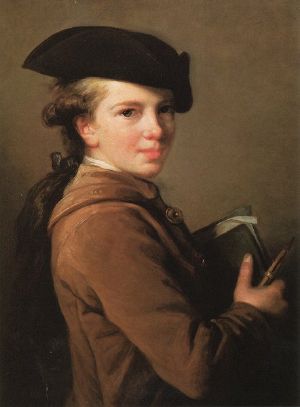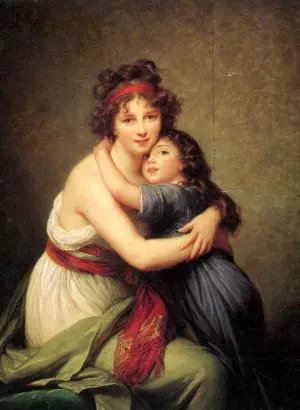Élisabeth-Louise Vigée-Le Brun
| Élisabeth-Louise Vigée-Le Brun | |
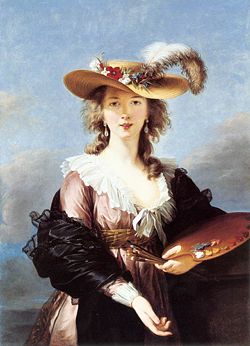 Self-portrait in a Straw Hat, 1782. | |
| Birth name | Marie Élisabeth-Louise Vigée |
| Born | April 16 1755 Paris, France |
| Died | March 30 1842 (aged 86) Paris, France |
| Nationality | |
| Field | Painting |
| Movement | Rococo |
Élisabeth-Louise Vigée-Le Brun (April 16, 1755 - March 30, 1842) was a French painter, and is recognized as the most famous woman painter of the eighteenth century. Her style is generally considered Rococo and shows interest in the subject of neoclassical painting. Vigée-Le Brun cannot be considered a purely Neoclassist in that she creates mostly portraits in Neoclassical dress rather than the History painting. In her choice of color and style while serving as the portrait painter to the Queen, Vigée-Le Brun is purely Rococo.
Early life
She was born in Paris on 16 April 1755, Marie Élisabeth-Louise Vigée, the daughter of a portraitist and fan painter, Louis Vigée, from whom she received her first instruction. Her mother was a hairdresser.[1] She was sent to live with relatives in Epernon until the age of 6 when she entered a convent where she remained for five years. Her father died when she was 12 years old. In 1768, her mother married a wealthy jeweler, Jacques-Francois Le Sèvre and the family moved to the rue Saint-Honoré close to the Palais Royal. During this period Elisabeth benefited by the advice of Gabriel François Doyen, Jean-Baptiste Greuze, Joseph Vernet, and other masters of the period.
By the time she was in her early teens, Elisabeth was painting portraits professionally. After her studio was seized, for practicing without a license, she applied to the Académie de Saint Luc, which willingly exhibited her works in their Salon. On 25 October 1774, she was made a member of the Académie.
Marie Antoinette
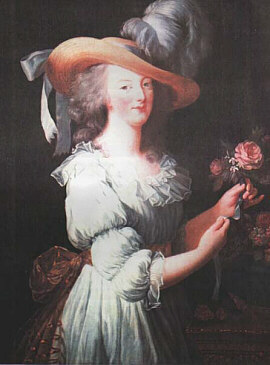
On 7 August 1775 she married Jean-Baptiste-Pierre Le Brun, a painter and art dealer. Vigée-Le Brun painted portraits of many of the nobility of the day and as her career blossomed, she was invited to the Palace of Versailles to paint Marie Antoinette, the French Queen consort.
So pleased was the queen that over the next several years, Vigée-Le Brun was commissioned to do numerous portraits of the queen, her children, and other members of the royal family and household. On 12 February1780 Vigée-Le Brun gave birth to a daughter Jeanne Julie Louise, whom she called "Julie".
In 1781 she and her husband toured Flanders and the Netherlands where seeing the works of the Flemish masters inspired her to try new techniques. There, she painted portraits of some of the nobility, including the Prince of Nassau.
On May 31, 1783, Vigée Le Brun was accepted as a member of France's Académie Royale de Peinture et de Sculpture as a painter of historical allegory. Adélaïde Labille-Guiard also was admitted on the same day.
The admission of Vigée-Le Brun was opposed on the grounds that her husband was an art dealer, but eventually they were overruled by an order from Louis XVI because Marie-Antoinette put considerable pressure on her husband on behalf of her painter.
The admission of more than one woman on the same day to the Académie encouraged comparisons among the works of the women instead of one woman contrasted with the existing members, who were men.
In 1789, she was succeeded as court painter to Marie Antoinette by Alexander Kucharsky.
French Revolution
After the arrest of the royal family during the French Revolution Vigée-Le Brun fled France with her young daughter Julie. She lived and worked for some years in Italy, Austria, and Russia, where her experience in dealing with an aristocratic clientèle was still useful. In Rome, her paintings met with great critical acclaim and she was elected to the Roman Accademia di San Luca.
In Russia, she was received by the nobility and painted numerous members of the family of Catherine the Great. While there, Vigée-Le Brun was made a member of the Academy of Fine Arts of Saint Petersburg. Much to Vigée-Le Brun's dismay, Julie married a Russian nobleman.[2]
She was welcomed back to France during the reign of Emperor Napoleon I. Much in demand by the élite of Europe, she visited England at the beginning of the nineteenth century and painted the portrait of several British notables including Lord Byron. In 1807 she traveled to Switzerland and was made an honorary member of the Société pour l'Avancement des Beaux-Arts of Geneva.
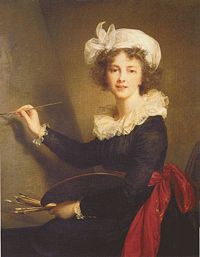
She published her memoirs in 1835 and 1837, which provide an interesting view of the training of artists at the end of the period dominated by royal academies. Her portrait of fellow neoclassical painter, Hubert Robert, is in Paris at Musee National du Louvre.
Still very active with her painting in her fifties, she purchased a house in Louveciennes, Île-de-France, and lived there until the house was seized by the Prussian Army during the war in 1814. She stayed in Paris until her death on March 30, 1842 when her body was taken back to Louveciennes and buried in the cemetery near her old home.
Her tombstone epitaph states "Ici, enfin, je repose…" (Here, at last, I rest…).
Vigée-Le Brun left a legacy of 660 portraits and 200 landscapes. In addition to private collections, her works may be found at major museums, such as Hermitage Museum, London's National Gallery, in Europe and the United States.
ReferencesISBN links support NWE through referral fees
- This article incorporates text from the Encyclopædia Britannica Eleventh Edition, a publication now in the public domain.
- Lebrun, Souvenirs, Paris, 1835–1837 (translated by Lionel Strachey, New York, 1903).
- Italian Wikipedia
- CyberPathways Art World
Related links
- Women Artists
External links
- Large gallery of Vigée-LeBrun's work; also articles, Memoirs, biographies
- Artcyclopedia entry on Elisabeth Vigée-Lebrun
- Vigée-Lebrun's Portrait of Carlo Gastone della Torre di Rezzonico at artnet
- Old Masters: Overlooked Women Artists
- Memoirs of Madame Vigée-Lebrun, translated by Lionel Strachey
- Neil Jeffares, Dictionary of pastellists before 1800, online edition
| Persondata | |
|---|---|
| NAME | Brun, Élisabeth-Louise Vigée-Le |
| ALTERNATIVE NAMES | Vigée, Marie Élisabeth-Louise |
| SHORT DESCRIPTION | French painter |
| DATE OF BIRTH | April 16 1755 |
| PLACE OF BIRTH | Paris, France |
| DATE OF DEATH | March 30 1842 |
| PLACE OF DEATH | Paris, France |
Credits
New World Encyclopedia writers and editors rewrote and completed the Wikipedia article in accordance with New World Encyclopedia standards. This article abides by terms of the Creative Commons CC-by-sa 3.0 License (CC-by-sa), which may be used and disseminated with proper attribution. Credit is due under the terms of this license that can reference both the New World Encyclopedia contributors and the selfless volunteer contributors of the Wikimedia Foundation. To cite this article click here for a list of acceptable citing formats.The history of earlier contributions by wikipedians is accessible to researchers here:
The history of this article since it was imported to New World Encyclopedia:
Note: Some restrictions may apply to use of individual images which are separately licensed.
